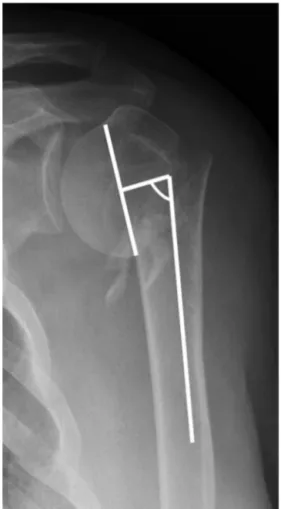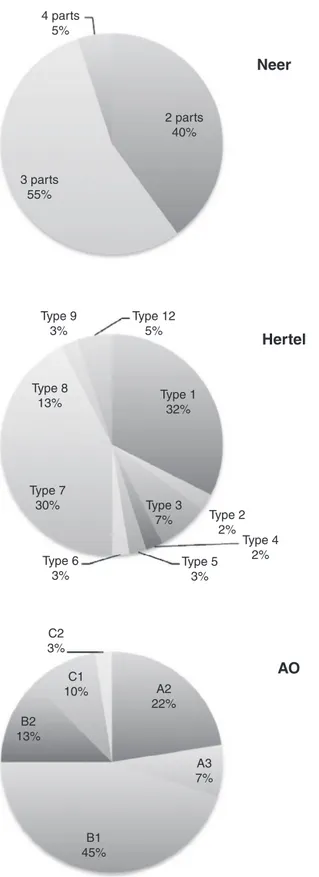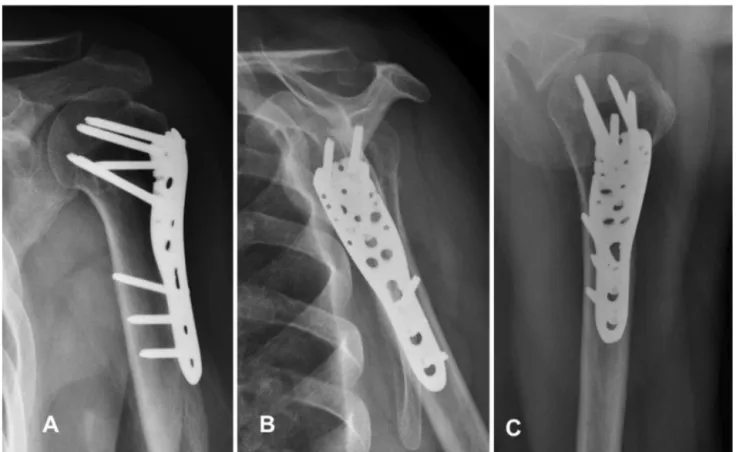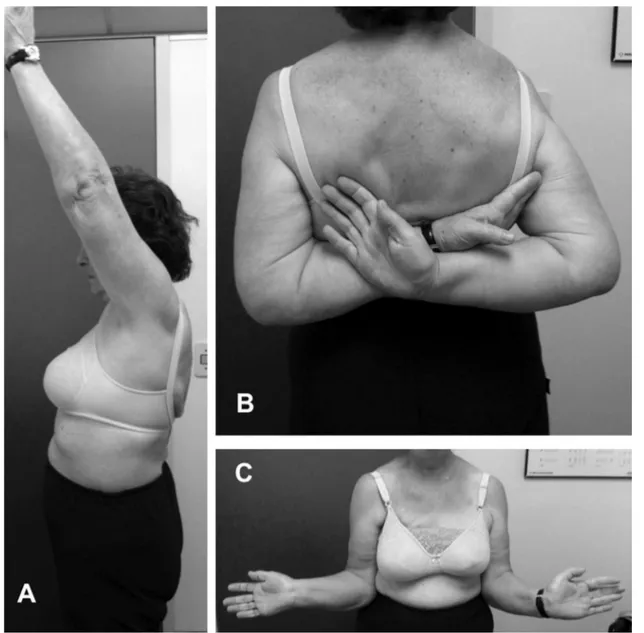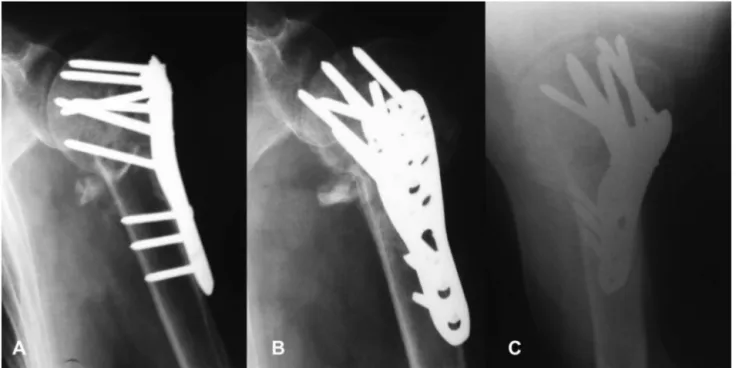w w w . r b o . o r g . b r
Original
Article
Outcomes
evaluation
of
locking
plate
osteosynthesis
in
displaced
fractures
of
the
proximal
humerus
Mauro
Emilio
Conforto
Gracitelli
∗,
Frederico
Lafraia
Lobo,
Gustavo
Maximiano
Aliperti
Ferreira,
Marcos
Vianna
da
Palma,
Eduardo
Angeli
Malavolta,
Eduardo
Benegas,
Kodi
Edson
Kojima,
Arnaldo
Amado
Ferreira
Neto,
Jorge
dos
Santos
Silva
InstitutodeOrtopediaeTraumatologia,FaculdadedeMedicina,UniversidadedeSãoPaulo,SãoPaulo,SP,Brazil
a
r
t
i
c
l
e
i
n
f
o
Articlehistory:
Received2August2012 Accepted29August2012
Keywords: Humeralfractures Fracturefixationinternal Treatmentoutcome
a
b
s
t
r
a
c
t
Objective:Toevaluatefunctionaloutcomes,radiographicfindingsandcomplicationsof prox-imalhumeralfracturestreatedwithlockingplatesandtodetermineprognosticfactorsfor successfulclinicaloutcomes.
Methods:Fortypatientsundergoinginternalfixationoffracturesoftheproximalhumerus withthePhilos®platewereincludedinthestudy.Thesurgerieswereperformedbetween
2004 and 2011 and the patients underwent radiographic and clinical evaluation, by Constant–MurleyandDashscore.Outcomeswereanalyzedbyuseofmultivariateregression withseveraldifferentvariables.
Results:Patientswereonaverageof61.8±16.28years,andmostwerefemale(70%).The Constant–Murleyscorewas72.03±14.01andDashscorewas24.96±19.99.The postopera-tiveradiographsshowedahead-shaftangleof135.43◦±11.82.Regressionanalysisshowed
thatthepatient’sageandtheHertelclassificationinfluencedtheConstant–Murleyscale (p=0.0049and0.012,respectively).OtherprognosticcriteriasuchasNeerandAO classifi-cation,head-shaftangle,thepresenceofmetaphysealcomminutionandextensionofthe humeralmetaphysealfragmentshowednoeffectonprognosis.Complicationsoccurredin fourpatients(10%).
Conclusion: Thefixation with the Philos® plate provided goodclinicaland radiographic
resultsinfracturesoftheproximalhumerus,withalowcomplicationrate.Patient’sage andHertelclassificationweredefinedasprognosticfactorsthatledtoworsefunctional outcomes.
©2013SociedadeBrasileiradeOrtopediaeTraumatologia.PublishedbyElsevierEditora Ltda.Allrightsreserved.
∗ Correspondingauthor.
E-mail:mgracitelli@gmail.com(M.E.C.Gracitelli).
Avaliac¸ão
do
resultado
do
tratamento
cirúrgico
das
fraturas
desviadas
do
terc¸o
proximal
do
úmero
com
placa
pré-moldada
com
parafusos
bloqueados
Palavras-chave: Fraturasdoúmero Fixac¸ãointernadefraturas Resultadodetratamento
r
e
s
u
m
o
Objetivo: Avaliarosresultadosclínicoseradiográficoseascomplicac¸õesdasfraturasdo terc¸oproximaldoúmerotratadascomaplacaPhilos®ecorrelacionaressesresultadoscom
critériosprognósticos.
Métodos: Foramestudados40pacientessubmetidosaosteossíntesedefraturasdoterc¸o proximaldoúmerocoma placaPhilos®.Ascirurgiasforamfeitas entre2004e 2011e
ospacientesforamsubmetidosaavaliac¸ãofuncional(escalasdeConstant–MurleyeDash [DisabilityofArm-Shoulder-Hand])eradiográfica.Osresultadosfuncionaisforam correla-cionadoscomvariáveisclínicaseradiográficaspormeioderegressãomúltipla.
Resultados: Ospacientesapresentavamemmédia61,8±16,28anoseamaioriaeradosexo feminino(70%).Observamospontuac¸ãode72,03±14,01pelaescaladeConstant–Murley e24,96±19,99peladeDash.Aradiografiapós-operatóriaevidenciouumângulo cabec¸a-diáfisede135,43◦±11,82.Aanáliseporregressãodemonstrouqueaidadedopacienteea
classificac¸ãodeHertelexerceminfluênciadiretanaescaladeConstant–Murley(p=0,0049 e0,012,respectivamente).Outroscritériosprognósticos,comoaclassificac¸ãodeNeereAO, oângulocabec¸a-diáfise,apresenc¸adecominuic¸ãometafisáriaeaextensãodofragmento metafisárionãodemonstraraminfluêncianoprognósticoemnossaamostra.Complicac¸ões ocorreramemquatropacientes(10%).
Conclusão:AosteossíntesecomaplacaPhilos®proporcionou,emnossaamostra,bons
resul-tadosclínicoseradiográficos,combaixoíndicedecomplicac¸ões.Aidadedopacienteea classificac¸ãodeHertelforamdemonstradascomofatorespreditoresdoresultadofuncional. ©2013SociedadeBrasileiradeOrtopediaeTraumatologia.PublicadoporElsevier EditoraLtda.Todososdireitosreservados.
Introduction
Fracturesoftheproximalthirdofthehumerusaccountfor around 4–5%of allfractures and are the second common-esttypesintheupperlimbs.1Theirincidenceincreaseswith
age andwomen are affected up totwiceas oftenas men. Justaswithotherfracturesrelatingtoosteoporosis,the inci-dence of fractures of the proximal third of the humerus presentsanincreasingtrend.1Inelderlypatients,theproximal
thirdofthehumerusiscommonlyosteoporotic,whichmakes it difficult to fix and stabilize using traditionalplates and screws.2,3 Severaltechniqueshavebeendescribedfor
treat-ingthesefractures,includingfixationwithaplateandscrews, laminarplate,intramedullarynail,percutaneouspinsor ten-sionband,orusingpartialarthroplasty.4–6 Premoldedplates
withlockingscrewsareconsideredtobethemainimplants forincreasing the mechanical stability ofthese fractures.5
Severalclinicalstudieshaveshowngoodresultsinrelation to shoulder function and consolidation with this type of implant.7–9 Clinical and intraoperative variables have been
describedasprognosticcriteriaforthesefractures,including: age,fractureclassification,adequacyofreductionandplate positioning.10–13
Thecomplicationratefromusingthesesynthesismaterials ishighandmayresultbothfromthefracturepattern14,15and
fromthesurgicaltechnique.7 Inarecentsystematicreview,
Sprouletal.7demonstratedacomplicationrateof49%among
514patients,withareoperationrateof14%.
The aim ofthis study was to evaluate the clinical and radiographicresultsandcomplicationsfromfracturesofthe proximalthirdofthehumerustreatedwiththePhilos®plate andcorrelatetheseresultswithprognosticcriteria.
Methods
Between2004and2011,86patientsunderwentoperationsto treatdisplacedfracturesoftheproximalthirdofthehumerus, which were fixed usinga fixed-anglepremolded plate and proximalscrewsmadebyPhilos®(Synthes®).Theoperations wereperformedbyfivedifferentsurgeonswithexperiencein surgical treatmentforthesefractures.These patients were invitedtomakeareturnvisitbetweenAugust2011andJuly 2012,and40ofthemcameforreassessment(40shoulders). Theother patients didnotcomebecause ofdeath, change oftelephonenumberorrefusaltoparticipateinthe investi-gation. Thedisplacement parametersforindicatingsurgery were basedonthe Neercriteria,withdisplacement greater than 45◦ or1cm betweenthe fragments (or0.5cm forthe
Intervention
The procedures were performed under general anesthesia in association with interscalene block, and antimicrobial prophylaxisconsistingoffirst-generationcephalosporinwas usedfor24h.
Thepatientswerepositionedinhorizontaldorsal decubi-tus,withthedorsumelevatedat30◦.Adeltopectoralaccess
routewasused.Thetendonsofthesupraspinatus, infraspina-tus and subscapularis were repaired using nonabsorbable suturingthreadinordertoaidinreducingandfixingthe tuber-cles.Afterthereduction,radioscopywasusedtoconfirmthat thefragmentshadbeenadequatelypositioned.Provisional fix-ationusingsteelwireswasthenperformed.ThePhilos®plate waspositionedaround1cmlaterallytothebicipitalgroove, anditsheightwasobservedbymeansofradioscopy.Therepair wiresofthetendonswerepassedthroughholesintheplate. Afterthefracturehadbeenreducedandtheplatehadbeen adequatelypositioned,definitivefixationwasperformed,with lockingscrewsinsertedproximally(minimumoffive)16and
corticalorlockingscrewsdistally(minimumofthree). Follow-ingthis,knotsweremadeinthecuffrepairthreads.
Aftertheoperation,thepatientswerekeptusingasling forfourweeks.Activemovementsoftheelbow,wristand fin-gerswerestartedduringtheimmediatepostoperativeperiod. Passivemovement oftheshoulderwas startedonthe14th dayaftertheoperation,whichallowedflexionofupto90◦,
externalrotationandabductionastolerated,withswinging exercises.Aftertheendofthefourthweek,assistedandfree activemovementswerestartedinallplanes.Strengthening wasstartedafterthefracturehadconsolidated.
Outcomes
The patients were evaluated clinically by means of the Constant–Murley17andDASH18functionalscales.
Radiographswereperformedpreoperativelyinaccordance with the trauma series. After the operation, the following views were produced: anteroposterior with 30◦ of external
rotation,lateralintheplaneofthescapulaandlateralaxillary. Theprimaryoutcome wastheConstant–Murleyevaluation. ThesecondaryoutcomesweretheDASHfunctionalscale,the head-shaftangle andthe presenceof complications. Com-putedtomographywasrequiredforeightpatients.
Inadditiontotheoutcomes,thefollowingvariableswere evaluated:
Factorsintrinsic tothepatient: gender,ageand dominant side.
Factorsrelatingtotheinjury:sideaffected,fracture mecha-nism,fractureclassification(Neer,19Herteletal.14andAO20),
extentofthemetaphysealfragmentofthehumeralhead, displacementofthemedialfragmentoftheheadinrelation tothelower shaft ofless than 2mm,position ofthe dis-placementofthe head(varusorvalgus),head-shaftangle (anteroposteriorradiographicview)(Fig.1)andpresenceof metaphysealcomminution.
Fig.1–Head-shaftangleof80◦,whichdemonstratesvarus displacement.
Factorrelatingtotheintervention:timeelapsedbetweenthe traumaandthesurgicaltreatment.
Postoperative radiographic criteria: head-shaft angle, heightoftheplateinrelationtothetopofthehumeralhead (Fig.2A),heightofthetuberosityinrelationtothetopofthe humeralhead(Fig.2B),distancebetweentheanteroinferior borderoftheanatomicalneckandtheshaft,andpresenceof aninferomedialscrew(Fig.3AandB).
Clinical and radiographic complicationswere evaluated: postoperativeinfection,looseningofthesynthesismaterial, osteonecrosis,pseudarthrosis,secondarydisplacementofthe fracture, looseningofthescrews, protrusionofscrewsinto thejointandsecondaryarthrosis.Theneedforanewsurgical proceduretotreatcomplicationsortoremovethesynthesis materialwasrecorded.
Statisticalanalysis
Fig.2–(A)Heightofthetuberosityinrelationtothetopof thehumeralhead.Thevaluesareconsideredtobenegative whenthetuberosityisbelowthetopofthehead;(B)height oftheplateinrelationtothetopofthehumeralhead.
variables,andtheMann–WhitneyUtesttomakecomparisons betweentwounpairedquantitativevariables.
The variables identified as potential predictors for the resultsfrom theConstant andDASHscaleswere evaluated inunivariablemodebymeansoflinearregressionandwere thensubjectedtomultipleregressionanalysis.Allthefactors were insertedinaninitialmodeland thenthe factorsthat presentedlowerassociation(p>0.05)wereexcludedfromthe model,whichmaintainedclinicalsense.
Thesignificancelevelof5%wasused.TheStata®statistical software(version10.0)wasusedforthedescriptiveanalysis, andSPSS19.0forWindowswasusedfortheregressions.
Results
The patients’ mean ageat thetime offracture occurrence was61.8±16.28years.Therightsidewasaffectedin22cases (55%)andthedominantsidein25(62.5%).Fracturesweremore prevalentamongfemales,with28cases(70%).
Themedianlengthoftimebetweenthefractureandthe osteosynthesiswas8.5days(p25%5;p75%14).
Themostprevalenttraumamechanismwasafalltothe ground,with26cases(65%).Fallsfromaheightwere respon-sibleforsevenfractures(17.5%),whilemotorcycleaccidents accountedfortwo(5%).Other causesoccurredinfivecases (12.5%).
Five patients(12.5%)presentedassociatedfractures.Two patients(5%)hadrotatorcufftears,whichwereobserved dur-ingtheoperationandcompletelyrepair.
AccordingtotheNeerclassification,22patients(55%) pre-sentedfracturesinthreeparts,16(40%)intwopartsandonly two(5%)infourparts.Patterns1(13cases,32.5%)and7(12
4 parts 5% 2 parts 40% 3 parts 55% Type 9 3% Type 12 5% Type 1 32% Type 8 13% Type 7 30% Type 6 3% C2 3% A2 22% C1 10% B2 13% B1 45% A3 7%
AO
Hertel
Neer
Type 5 3% Type 4 2% Type 37% Type 2
2%
Fig.4–Percentagedistributionofthefracturesaccordingto theNeer,HertelandAOclassifications.
cases,30%)werethemostprevalenttypesaccordingtothe Hertelclassification.Subtype11-B1predominatedintheAO classification,with18cases(45%).Fivecases(12.5%)were clas-sifiedastypeC.Thecompleteanalysisofthetypesoffractures accordingtothesethreeclassificationscanbeseeninFig.4.
Theanalysisofthepreoperativeradiographsshowedthe cephalic fracture had metaphyseal extent of a median of 12mm(p25%8mm;p75%20mm).Fourteencases(35%) pre-sentedmetaphysealextentof8mmorless.Twelvecases(30%) presented significant displacement between the humeral head and the diaphysis, with signs ofa medial periosteal lesion.Six cases(15%)presentedanassociation betweena medialperiosteallesionandametaphysealfragmentlessthan or equalto8mm. Noneofthese casespresenteda typeC fractureintheAOclassification.
Nineteencases(47.5%)presentedvalgusdisplacementof the head and 16 (40%), varus. Four patients (10%) did not presentanydisplacement ofthehead(onlyofthetubercle) and one(2.5%)had atranslation without angular displace-ment.Metaphysealcomminutionwaspresentinsevencases (17.5%).
Thepostoperativeradiographsshowedahead-shaftangle of135.43◦±11.82.Medialmetaphysealsupportwasobserved
in38cases(95%).Theheightofthegreatertuberclein rela-tiontothetopofthehumeralheadwas−5.03mm±5.30.The distancebetweenthemedialborderoftheheadandthe meta-physiswas13.09mm±6.32.Thetopoftheplatewasatamean
distanceof15.97mm±6.97fromthemostproximalportion ofthegreatertubercle.In32cases(80%),inferomedialscrews wereinserted.Innocasewastheplatepositionedoutsideof theacceptablepatterns(Fig.5A–C).
Functionalassessmentonthepatientswasdoneaftera medianintervalof21monthsafterthesurgery(p25%12;p75% 32.5). Thepatientspresentedresultsof72.03±14.01points according to the Constant–Murley scale and 24.96±19.99 accordingtotheDASHscale(Fig.6A–C).
Regressionanalysisoftheinfluenceofthedifferent prog-nosticcriteriademonstratedthatthepatient’sageandHertel classificationhad adirectinfluence onthe resultfrom the Constantassessment(p=0.0049and0.012,respectively).Other prognosticcriteria,suchastheNeerandAOclassifications,the head-shaftangle,thepresenceofmetaphysealcomminution andtheextentofthemetaphysealfragment,didnotshowany influenceontheprognosis,asdeterminedusingthefunctional scales,inoursample.
Four patients (10%) presentedcomplications: secondary displacement of the fracture (Fig. 7A and B), osteonecro-sis, screw positioned intra-articularly and postoperative stiffness. The patients with secondary displacement and osteonecrosispresentedsecondaryprotrusionofthescrews intra-articularly.Fourpatients(10%)underwentreoperation. One patient (2.5%) presented loss of the reduction of the greatertubercle,withproximalretractionof1cm.No occur-rences ofinfection, loosening ofthe synthesis material or secondaryarthrosiswasobserved.
Discussion
Osteosynthesis of fractures of the proximal third of the humerus using premolded plates with locking screws pro-ducessatisfactoryresults.Throughasystematicreviewon514 patients,Sprouletal.7foundthatthemeanscorewas74points
Fig.5–Radiographicevaluationofacasewithawell-positionedplateandadequatelyreducedfracture.(A)Anteroposterior; (B)lateral;(C)axillary.
scale.Ourstudyshowedsimilarresults,with72.03and24.96 points,respectively.
Severalvariablesrelatingtothepatient,typeoffractureand surgicaltechniquehavebeenstudiedasprognosticfactorsfor thesefractures.10–13
Patient’sageisaparameterthathasaninfluenceonthe finalresult.12Ourstudydemonstratedthatpatientswhowere
moreelderlypresentedworseresultsaccordingtothe Con-stant and DASH scales. Other factors that we studied in relationtoourpatientsdid notshowany influenceonthe regressionmodelused.
Amongtheclassificationevaluatedinourstudy,onlythe onedescribedbyHerteletal.14demonstratedanyinfluence
ontheclinicalresult.
Theclassificationorbinarydescriptivesystemdescribed byHertelet al.14 consistsofidentifyingthe morphologyof
the fracture by investigating the following fracture lines: (1)between thegreater tubercleand thehumeral head;(2) betweenthegreater tubercleandtheshaft;(3)betweenthe lessertubercle and thehead; (4) between thelesser tuber-cleand theshaft;and (5)betweenthegreatertubercleand thelessertubercle.Basedonidentifyingthesetraits,12types offracture canbedetermined.Inadditiontosubtypes,the authorssuggestthatotherfactorsleadingtoapoorprognosis shouldbeaddedtotheclassification.Themostimportantare theextentofthemedialmetaphysealfragmentofthehead andtheposteromedialperiosteallesion,indicatedbya dis-placementgreaterthan2mmbetweentheheadandthe prox-imalfragmentoftheshaft.Thecombinationofametaphyseal
fragmentsmallerthan8mmoramedialperiosteallesionand involvementoftheanatomicalneckdemonstratesthatthere isa97%riskofischemiaofthehumeralhead.Theinitial dis-placementofthefractureandeventhepresenceofdislocation oftheheadweredescribedbytheauthorsascriteriaoflesser importancefortheprognosis.Inourstudy,thebinary descrip-tive classificationwas adetermining factor forthe clinical result(p=0.0049).Inthestudy byHerteletal.,14the riskof
ischemiawasdetermined,whichdoesnotdirectlyimplythat osteonecrosiswilloccuranddoesnotnecessarilydeterminea worseclinicalresult.Inourstudy,fourcases(10%)were clas-sifiedintheworsttypesoftheHertelclassification(types2, 9,10,11and12).Onlyonecasepresentedosteonecrosis,and thisdidnotpresentthecriteriaassociatedwithapoor progno-sis.Wewereunabletofindacorrelationbetweentheclinical resultsandthepresenceofametaphysealfragmentsmaller than8mmoramedialperiosteallesion.
TheAOclassificationwasshownbyHardermanetal.21to
beaprognosticfactorfortheclinicalresultandpresenceof complications.Onthecontrary,Sudkampetal.12didnotfind
Fig.6–Functionalevaluationonapatient12monthsaftertheoperation.(A)Elevation;(B)internalrotation;(C)external rotation.
Metaphyseal comminution,22 varus or valgus pattern of
headdisplacement11andhead-shaftangle13havebeen
indi-catedasimportantindeterminingtheprognosisforfractures. However,wedidnotobserveanycorrelationbetweenthese variablesandtheclinicalresultsfromourstudy.
Adequatereductionofthefractureisessentialfor achiev-ing a good clinical result from fixation of fractures of the proximalthirdofthehumerus.10,12Severalreduction
param-etershavebeendescribed,14,23–25andrigorousobservanceof
theseisimportantforobtaininggoodresults.Lackofmedial metaphysealsupportfortheheadmayleadtoearlylossofthe reductionandpenetrationofthejointbythescrews, partic-ularlyincaseswithmetaphysealcomminutionandprimary varus displacement.Owsley et al.26 demonstrated that the
incidenceofvarus deformity was25% and that screw cut-outoccurredin23%ofthecasesofthisfracturepattern.In ourstudy,onlyonepatient(2.5%)presentedsecondarylossof reduction.
Factorsrelatingtothepositioningoftheplateandscrews mayalsoinfluencetheclinicalresults.15,24,27–29Themost
fre-quentcomplicationsdescribedfrom osteosynthesisusinga lockingplaterelatetoperforationofthehumeralheadcaused bytheproximalscrews,andtoimpactsecondarytohigh posi-tioningoftheplate.25–27
Themeanvaluesforthereductionparametersinourstudy werewithinthenormalpatterns.Theplatewasadequately positionedinallthecases(Fig.6A–C).Inonecase,ascrewthat wastoolongwasinsertedanditremainedinsidethejoint:it had toberemoved.In80%ofthecases,atleastonescrew wasinsertedintheinferomedialregion,whichwasreported byZhangetal.24asimportantformaintainingthereduction
incomplexfactures.Therewas nocorrelationbetweenthe reductionandplatepositioningparametersandthefunctional scales,orinrelationtothepresenceofcomplications.
Inasystematicreview,Sprouletal.7showedthatthe
Fig.7–Radiographicevaluationofacasewithsecondaryvaruscollapseandprotrusionofcrewsintothejoint.(A) Anteroposterior;(B)lateral;(C)axillary.
smaller rate (10%). Webelieve that our low incidencewas relatedtorigorinapplyingtheprinciplesofreductionand ade-quatepositioningoftheplateandscrews.Thesmallnumber ofcomplexfracturesorfractures withfactorsgivingapoor prognosisalsocontributedtowardthispicture.
Our study presents certain limitations. Multivariable regression analysis enables control over and assessment of different prognostic criteria and diminishes the bias of confounding factors.12 Furthermore, it may quantify their
associationwiththefinaloutcome.However,thesizeofour samplelimitedtheassessmentofmanyvariables andmay havegeneratedatypeII(beta)errorduetoinsufficientstudy power.Anotherlimitationisthatthelengthofpostoperative follow-up varied between the patients, which made com-parative analysis difficult. In addition, seven cases (17.5%) presentedlengthsoffollow-upoflessthanoneyear.Ifthese patientswereexcluded, themeanfollow-up wouldbecome 25.4months.
As positive points, our study presented a homogenous sampleofpatientswhounderwentoperationsusinga stan-dardizedtechnique,followingtheprinciplesofreductionand platepositioning.Theevaluationontheradiographic prognos-ticcriteriawasstandardizedanddonebyanevaluatorwho wasblindedinrelationtothepatients’follow-up.Ourstudy drawsattentiontotheneedtocarefullyassessdifferent prog-nosticfactorsrelatingtofracturesoftheproximalthirdofthe humerus.
Conclusion
Osteosynthesis of fractures of the proximal third of the humerus using a Philos® plate provided good clinical and radiographicresultsfromoursample,withalowcomplication
rate.Thepatient’sageandHertelclassificationwereshownto bepredictivefactorsregardingthefunctionalresult.
Conflicts
of
interest
Theauthorsdeclarenoconflictsofinterest.
r
e
f
e
r
e
n
c
e
s
1.PalvanenM,KannusP,NiemiS,ParkkariJ.Updateinthe epidemiologyofproximalhumeralfractures.ClinOrthop RelatRes.2006;442:87–92.
2.HawkinsRJ,BellRH,GurrK.Thethree-partfractureofthe proximalpartofthehumerus.Operativetreatment.JBone JointSurgAm.1986;68(9):1410–4.
3.SehrJR,SzaboRM.Semitubularbladeplateforfixationinthe proximalhumerus.JOrthopTrauma.1988;2(4):327–32. 4.ChudikSC,WeinholdP,DahnersLE.Fixed-angleplatefixation
insimulatedfracturesoftheproximalhumerus:a
biomechanicalstudyofanewdevice.JShoulderElbowSurg. 2003;12(6):578–88.
5.SchlegelT,HawkinsR.Displacedproximalhumeralfractures: evaluationandtreatment.JAAOS.1994;2(1):54–78.
6.ChecchiaSL,MiyazakiAN,DoneuxP,FregonezeM,SilvaLA, LoboAC,etal.Avaliac¸ãodotratamentocirúrgicodafratura emduaspartesdocolocirúrgicodoúmerocomplacaPFS80. RevBrasOrtop.2004;39(10):555–67.
7.SproulRC,IyengarJJ,DevcicZ,FeeleyBT.Asystematicreview oflockingplatefixationofproximalhumerusfractures. Injury.2011;42(4):408–13.
8.CohenM,AmaralMV,MonteiroM,BrandãoBL,MottaFilho GR.Osteossíntesedasfraturasdaextremidadeproximaldo úmerocomsistemadeplacadeângulofixocomparafusos bloqueados:técnicaeresultados.RevBrasOrtop.
9. BarbosaRI,MarcolinoAM,FonsecaM,deCR,MazzerN,Zatiti SC.Avaliac¸ãofuncionalretrospectivadepacientescom fraturaproximaldeúmerofixadacomplacacomparafusos deângulofixopararegiãoproximalnoúmero.ActaOrtop Bras.2008;16(1):89–92.
10.KrappingerD,BizzottoN,RiedmannS,KammerlanderC, HenggC,KralingerFS.Predictingfailureaftersurgicalfixation ofproximalhumerusfractures.Injury.2011;42(11):
1283–8.
11.ForuriaAM,deGraciaMM,LarsonDR,MunueraL, Sanchez-SoteloJ.Thepatternofthefractureand displacementofthefragmentspredicttheoutcomein proximalhumeralfractures.JBoneJointSurgBr. 2011;93(3):378–86.
12.SüdkampNP,AudigeL,LambertS,HertelR,KonradG.Path analysisoffactorsforfunctionaloutcomeatoneyearin463 proximalhumeralfractures.JShoulderElbowSurg. 2011;20(8):1207–16.
13.LeeCW,ShinSJ.Prognosticfactorsforunstableproximal humeralfracturestreatedwithlocking-platefixation.J ShoulderElbowSurg.2009;18(1):83–8.
14.HertelR,HempfingA,StiehlerM,LeunigM.Predictorsof humeralheadischemiaafterintracapsularfractureofthe proximalhumerus.JShoulderElbowSurg.2004;13(4): 427–33.
15.AgudeloJ,SchürmannM,StahelP,HelwigP,MorganSJ,Zechel W,etal.Analysisofefficacyandfailureinproximalhumerus fracturestreatedwithlockingplates.JOrthopTrauma. 2007;21(10):676–81.
16.ErhardtJB,StoffelK,KampshoffJ,BadurN,YatesP,KusterMS. Thepositionandnumberofscrewsinfluencescrew
perforationofthehumeralheadinmodernlockingplates:a cadaverstudy.JOrthopTrauma.2012;26(10):e188–92. 17.ConstantCR,GerberC,EmeryRJH,SøjbjergJO,GohlkeF,
BoileauP.AreviewoftheConstantscore:modificationsand guidelinesforitsuse.JShoulderElbowSurg.
2008;17(2):355–61.
18.OrfaleAG,AraújoPMP,FerrazMB,NatourJ.Translationinto BrazilianPortuguese,culturaladaptation,andevaluationof thereliabilityoftheDisabilitiesoftheArm,Shoulderand HandQuestionnaire.BrazJMedBiolRes.2005;38(2):293–302.
19.NeerCS.DisplacedproximalhumeralfracturesI. Classificationandevaluation.JBoneJointSurgAm. 1970;52(6):1077–89.
20.MullerME,NazarianS,KochP,SchatzkerJ.The comprehensiveclassificationoffracturesoflongbones. Berlin:Springer;1990.
21.HardemanF,BollarsP,DonnellyM,BellemansJ,NijsS. Predictivefactorsforfunctionaloutcomeandfailurein angularstableosteosynthesisoftheproximalhumerus. Injury.2012;43(2):153–8.
22.OsterhoffG,HochA,WannerGA,SimmenH-P,WernerCML. Calcarcomminutionasprognosticfactorofclinicaloutcome afterlockingplatefixationofproximalhumeralfractures. Injury.2012;43(10):1651–6.
23.SinhaS,KellyCP.Fixedanglelockingplatesforproximal humeralfracturefixation.AnnRCollSurgEngl. 2010;92(8):631–4.
24.ZhangL,ZhengJ,WangW,LinG,HuangY,ZhengJ,etal.The clinicalbenefitofmedialsupportscrewsinlockingplatingof proximalhumerusfractures:aprospectiverandomizedstudy. IntOrthop.2011;35(11):1655–61.
25.TorchiaME.Technicaltipsforfixationofproximalhumeral fracturesinelderlypatients.InstrCourseLect.2010;59:553–61. 26.OwsleyKC,GorczycaJT.Fracturedisplacementandscrew
cutoutafteropenreductionandlockedplatefixationof proximalhumeralfractures.JBoneJointSurgAm. 2008;90(2):233–40.
27.HirschmannMT,QuarzV,AudigeL,LudinD,MessmerP, RegazzoniP,etal.Internalfixationofunstableproximal humerusfractureswithananatomicallypreshaped interlockingplate:aclinicalandradiologicevaluation.J Trauma.2007;63(6):1314–23.
28.GardnerMJ,WeilY,BarkerJU,KellyBT,HelfetDL,LorichDG. Theimportanceofmedialsupportinlockedplatingof proximalhumerusfractures.JOrthopTrauma. 2007;21(3):185–91.
